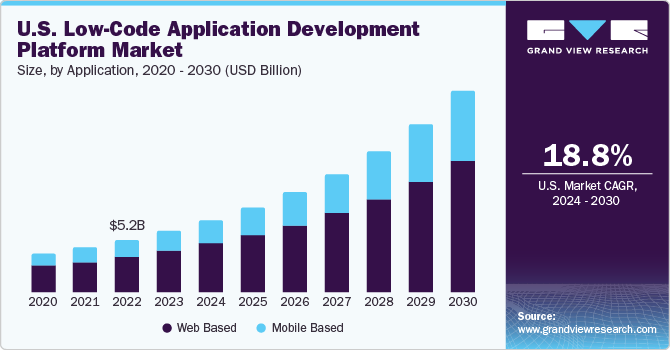Handy Tips On Deciding On Legacy application modernization with Low-code
Wiki Article
Development Of Low-Code Apps Is Quicker.
Visual Development Environment:
Drag-and-Drop Interfaces: Low-code platforms provide visual tools for designing applications. Drag-and-drop tools allow developers to rapidly assemble applications without having to write code.
Templates and components that have been pre-built Many platforms that support low-code come with templates and components pre-built, allowing developers to prototype quickly and develop applications without needing to start completely from beginning from scratch.
Coding requirements that are less invasive:
Automated Coding Generation: Low-code platforms generate code automatically based on the visual model developed by developers. This reduces need for manual code coding.
Reusable component: Developers can utilize the same components on various projects. This helps reduce time spent on testing and writing code.
A more efficient collaboration
Low-code development platforms are typically equipped with tools, such as deployment control, version control and testing. This allows seamless collaboration between teams.
Citizen Development: Business users as well as non-developers can help with the development of applications using simple interfaces, thus reducing bottlenecks often caused by limited availability of professionals.
Rapid Iteration & Prototyping
Rapid prototyping: Designers can create quickly prototypes in order to gather feedback and validate ideas, resulting in faster iteration cycles.
Simple Modifications. Low-code development's visual nature makes it easy for users to modify and upgrade their applications.
Pre-built Integrations:
API Integrations. Low-code platforms typically come with pre-built connectors as well as APIs for the most popular services, which reduces the time needed to integrate with other systems.
Data Integration: The instruments built in the software make it easier and accelerate the process of linking databases, other applications and data sources.
Deployment, scaling and deployment:
One-Click-Deployment: A lot of Low-Code platforms provide one-click deployment options. This cuts down on the amount of time and effort required to deploy an application.
Cloud-based Platforms: Cloud-based platforms which have low-code capabilities can manage infrastructure and scaling, meaning developers can focus on logic and functionality of applications rather than deployment logistics.
The efficiency of developing low-code applications is in its ability to simplify and automate various aspects of the application development. This allows for faster delivery of applications and faster adaption to changing requirements. Read the most popular wavemaker.com coding for more recommendations including app modernization, application modernization, cross platform mobile dev, application development platforms, developing mobile apps, stored sql procedures, stored sql procedures, rad development, rapid applications, rapid app development and more.

Benefits Of Developing Applications Using Low-Code With Respect To Governance And Security
Low-code application design offers many advantages when it comes to security and governance. Both are vital to making sure that applications remain safe, compliant and properly managed throughout their entire life cycle. Here are the key benefits: Centralized Governance:
Unified Management Console: Low-code applications typically have a central management console, where administrators are able to supervise and manage all applications and ensure that they have a consistent management system across the organization.
Role-Based Access Control RBAC (RBAC). These platforms often include robust access control by role, which gives administrators to create and apply their own access rules. This ensures that only those with permission can modify or access certain parts of the application.
The Compliance Process and Regulatory Adherence:
Many low-code platforms have built-in conformity features. They are designed to conform to industry standards and regulations like GDPR or HIPAA. They offer tools and frameworks to help ensure that applications meet these requirements.
Audit Trails and Logging : Audit trails, comprehensive logging and logs are typically integrated into businesses which allows them to monitor changes and track access. They also can verify compliance with external and internal laws.
Increased Security Measures
Data Encryption : Low-code platforms typically provide built-in encryption of data in transit and at rest. This ensures that sensitive information will be secured.
Security Certifications – Many lowcode companies have security certifications, such as ISO 27001 (or SOC2) that demonstrate their adherence to high security standards. Customers can rest assured that these companies adhere to these standards.
Automatic security updates for security:
Regular Patching and Updating Lowcode platforms typically handle regular security updates. These patches guard software from the latest threats without requiring the involvement of developers.
Security Monitoring - Continuous monitoring for security is usually part of the program. This gives real-time information and alerts about possible security threats.
Data Governance
Data Access Policy: These systems help organisations define and enforce policies for data access, making sure that only authorized individuals are able to access data, and they are using it in a proper manner.
Data Masking and Anonymization: Built-in tools for data masking & anonymization ensure the security of sensitive information, especially in development environments and testing environments.
Consistent Lifecycle Application Management:
Development and Deployment pipelines Lowcode platforms usually provide integrated development-and-deployment pipelines with security checks. They provide security throughout the application's lifecycle.
Version Control: The integrated version control facilitates the control of modifications. It also ensures that all modifications to the software can be recorded, and if required reversed. This is to ensure the integrity of the software.
User Authentication, Authorization and Authorization
Single Sign-On Support for single sign-on (SSO), and other advanced mechanisms of authentication simplify management and enhances security.
Multi-Factor Authentication Numerous platforms support multi-factor Authentication, which adds an extra layer to security when logging into applications.
Monitoring of Policy Enforcement and Compliance:
Low-code platforms usually come with policies templates pre-defined that allow organizations to establish governance and cybersecurity policies quickly.
Compliance Monitoring Tools: These offer continuous monitoring and reports on the status of compliance. This allows you to detect potential issues and take action to address them.
Integration into Existing Security Infrastructure:
Seamless Integration: Low-code platforms are designed to seamlessly integrate with the existing security infrastructure and tools, including identity management solutions SIEMs (Security Information and Event Management Solutions), and firewalls.
API Security: API security features built-in allow integration with other systems, securing the integrity of data as well as ensuring the integrity of the applications.
Best Practices and Training:
Guided Best Practices: A number of platforms provide guidelines and best practices for secure application development and help non-developers comply with security standards.
Security Training: Some companies of low-code provide courses and other resources for security to educate users about how to build and maintain secure applications.
Low-code development can provide a range of security and governance benefits that help ensure that applications are created and managed in a efficient, secure and compliant manner. These platforms have the tools and frameworks needed to secure sensitive data, enforce policies and maintain regulatory compliance, while facilitating managing and monitoring. See the best Legacy application modernization with Low-code for site examples including azure sql server, driver jdbc, app modernisation, push alerts, rapid app development, rad application development, push notifications, rapid application design, mobile app development platforms, low code platforms and more.

Regarding Support From Vendors And Community Support, Low-Code Application Development Has Many Advantages.
Low-code development platforms offer significant advantages when it comes to vendor support and the community. These are important for successful implementations, continual maintenance, and continuous improvement. Vendor Support
Comprehensive Technical Support:
Support Teams: Several Low-Code platforms provide access an experienced support team that can assist in technical issues, advice and troubleshooting.
24/7 Support Available: Certain vendors offer around-the-clock support, which is particularly beneficial for companies that are global and operate in various time zones.
Training and Onboarding:
Vendors offer structured learning programs such as webinars, tutorials, and certifications to help users become familiarized with the platform.
Personalized onboarding: Many vendors have customized services for customers who are new helping them to set up the platform correctly and tailor it to suit their needs.
Regular updates and enhancements
Continuous Improvements: Low-code providers frequently release updates, which include performance improvements as well as new features and security patches, in order to ensure that the platform is up-to-date.
Feedback Integration: Vendors incorporate feedback from users into their cycle of development to ensure that the platform is continually evolving to meet the ever-changing needs of their users.
Comprehensive Documentation:
The Documentation In Detail Users will find solutions to their questions by referring to an organized and detailed manual that covers all the aspects of the program starting from its basics to more sophisticated modifications.
API References In-depth API documentation allows developers to modify applications and connect low-code platforms with other platforms.
Consultation and Professional Services:
Expert Consulting: Vendors typically provide consulting services that assist with planning for strategic purposes, architecture design, and complex implementations, ensuring that users have the ability to leverage the platform to its fullest potential.
Custom Development Service: Some companies will provide customized development to develop functions or integrates for their customers that aren't easily available.
Community Support for the Community
Active User Communities
Forums and Discussion Panels A lot of Low-code platforms offer lively online communities, where users are able to ask questions, discuss solutions, and collaborate on best methods.
Virtual and local User Groups These groups offer opportunities to connect, share knowledge and share experiences.
Knowledge Sharing and Collaboration
Community-Contributed Resources: Users often share templates, modules, and extensions that they have developed, which can be reused or adapted by others, accelerating development and innovation.
Crowdsourced Solution Finding: The collective experience and wisdom of a group can be a valuable resource in solving difficult problems.
Learning and Development
Community-led training: Many communities provide webinars, workshops and training sessions led by experienced users.
Online Courses and tutorials Community members usually create and distribute online tutorials, courses, and how-to guides, making better educational resources available to all users.
Feedback and Influence
Community forums are usually an area where businesses can receive feedback from the community. This information can be used to create enhancements or new features.
Beta Testing Programs: Members of the community who are active could be able to be part of beta testing programs, giving users early access to brand new features as well as a say in shaping the platform's evolution.
Recognition and Encouragement
Many vendors offer communities recognition programs for example MVP programs (Most Valuable Professional) to acknowledge the contributions of members who are active in their respective communities.
Peer Support Community members often offer peer support by sharing their knowledge and offering guidance for those who aren't as knowledgeable. This creates a supportive friendly and supportive environment.
In general, the combination between strong vendor support and an engaged, active community offers a wide range of support for low-code development. Users will have the knowledge and resources to create, deploy and maintain their application.
